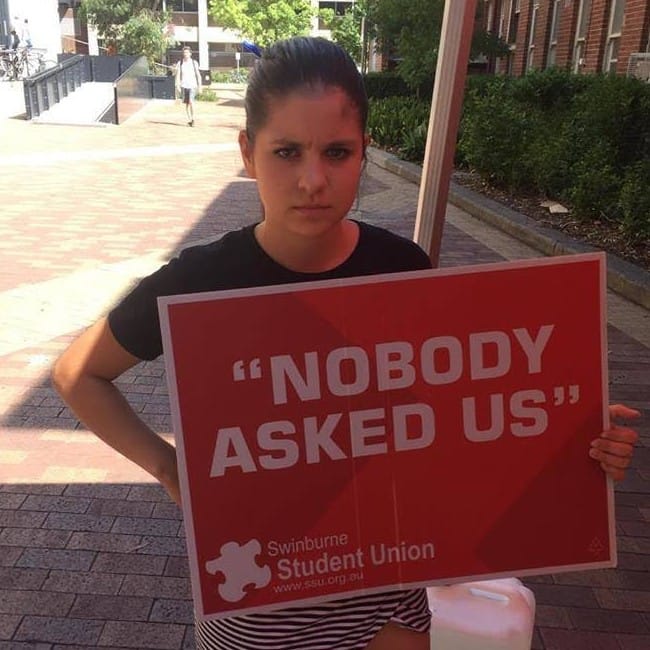Students angry at universities over the distribution of fee funds
A lack of consultation at three different universities regarding how the Student Services and Amenities Fee is distributed is leaving clubs ill-equipped to succeed.


By CHRISTIANE BARRO
Higher education powers are failing to prioritise student needs when allocating the Student Services and Amenities Fee (SSAF), say student representatives.
SSAF is a compulsory fee, averaging about $290, which is paid yearly by students to help fund non-academic services including clubs, events, sporting activities, financial, career advice and legal services.
This year, Swinburne Student Union received $199,500 of the $5.5 million of available SSAF revenue, the university revealed on its Student Services web page.
Student union president Caitlin Bruty said there was a “massive lack of culture on campus” because of inadequate resourcing and a shortage in financial funding for student services.
“People just come on, they leave and don’t hang around for anything,” Ms Bruty said.
The Swinburne Student Union is particularly concerned that clubs are not financially equipped to succeed.

An RMIT cheerleading squad was able to book out the Hawthorn Hotel for a self-funded event, whereas Ms Bruty said Swinburne University did not “have one club on campus that can really do that for an entire venue”.
Under the Student Services, amenities, representation and advocacy guidelines, universities are required to formally consult student representatives about how the SSAF should be appropriately distributed.
The Swinburne Student Union (SSU) was offered a non-negotiable 3 per cent increase in funding this year by Vice-President of Corporate Services Dr Andrew J Smith.
This came after one consultation in September, Ms Bruty said.
“We are told what the university thinks their plan is. Even if we say no, it should happen differently, nothing is going to change. I would say they don’t listen at all,” Ms Bruty said.
However, a university spokesperson said Dr Smith met with the SSU "a number of times during 2015 to discuss the SSAF process and the SSU funding proposal”.

The student union has launched a "Nobody Asked Us" photo petition as part of Swinburne’s WTF (Where's The Funding?) campaign. It focuses on where students want funds allocated and if they are happy with the final distribution of SSAF funds.
National Women's officer Heidi La Paglia said underfunding important services resulted in students being unaware of available programs because of an absence in marketing officers.
The recent Talk about it survey conducted by the National Union of Students revealed nearly 40 per cent of female students were uncertain whether their student organisation had a women’s officer.
“We are not prominent in the student eyes and that does mean students lose support,” Ms La Paglia said.
She said issues with funding often lead to students reducing or withdrawing from their study or at least suffering with their marks.
Swinburne University and the Student Union agreed to conduct a survey, which began on November 30 last year, to seek student input regarding the way SSAF would be distributed in 2016.
Ms Bruty criticised the survey for failing to explain how SSAF was distributed in 2015.
“Students don’t know where the money is already going to be able to then give the university the feedback on where the money should go … without that information its not possible for any sort of student to give meaningful feedback,” Ms Bruty said.

A Facebook poll conducted by the Swinburne Student Union revealed 92 of the 159 respondents did not even know about SSAF.
Student representatives at other universities voiced similar concerns.
Monash Student Association president Abigail Stapleton said although Monash University offered a level of consultation, it prioritised its GO8 status above student well-being.
Student organisations at Monash University’s Clayton, Caulfield, Berwick, Peninsula and Parkville campuses share 40 per cent of SSAF revenue, depending on the number of enrolments.
“We would love to be able to subsidise the cost of childcare, offer scholarships and emergency housing. However due to lack of funding these sorts of campaigns are difficult to implement,” Ms Stapleton said.

More than 650 students attended Monash University’s beach day in 2015. However, this number decreased by more than 50 per cent this year, with only 250 tickets sold.
The 2015 president of the Monash University Caulfield Student Union, Andrew Ware, said there had also been an absence of queer officers this year despite negotiating a larger space for the Queer Lounge in 2015.
“The elected queer representatives have had no presence on campus to represent the LGBTIQ community, which I find disgusting,” Mr Ware said.
The University of Melbourne is similarly experiencing a lack of transparency within consultations.
VCA Student Association Campus Co-ordinator Van Rudd said the university was “happy to continue to weaken unions”.
Although student representatives are invited to attend meetings, Mr Rudd said the university seemed to predetermine the result.
“It acts like it is consulting. It's very undemocratic … were left in the dark quite a lot,” he said.
As part of a recent SSAF survey conducted by Melbourne University, 77 per cent of students indicated the importance its student union had for the community as a whole.
Despite this, 34 per cent of the $4.6 million in SSAF was allocated to the UMSU (University of Melbourne Student Union) and 46 per cent of SSAF funds were allocated to the University of Melbourne in 2015, according to the UMSU website.
“The students are paying for what the university itself has enough profit to do,” Mr Rudd said.
“Lots of students, on personal levels, are much more frustrated with basic services,” he said.





